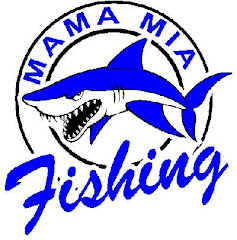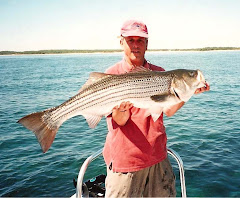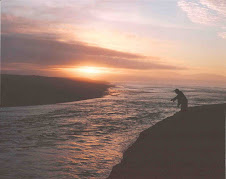
The very first streamer fly I ever tied was a Black Ghost, and that was many full moons ago. I took painstaking care to craft it true to its original recipe –my tying instructor would expect no less. It was a great fly for brook trout and largemouth bass. The second streamer of my young tying career was a Black Nose Dace. It too was a terrific trout fly and also accounted for its share of freshwater bass, but it did something else - it caught schoolie striped bass as well. I tied that first simple and classic “dace” more than thirty-three years ago and it is still a favorite pattern of mine, only in a slightly different form. I fundamentally super-sized the Dace for saltwater duty and found it to be a most effective fly for bass when early season sand eels are present in back bays and harbors.
I have always been a believer in the transferability of patterns and techniques from freshwater to saltwater and vice versa. What works for one species of fish often is effective for others. I have experienced that with fish like striped bass, salmon, redfish, snook and other species that have similar feeding habits and life styles. About eighteen years ago I started converting some of my favorite freshwater streamer flies for use in saltwater. The first of those were Pacific silver salmon flies that I discovered worked well for striped bass. After sixteen trips to Alaska fishing and catching all fives species of Pacific salmon I had amassed an arsenal of very effective patterns. I began thinking that some of those flies just might work on my home waters for striped bass. After all, stripers and Pacific salmon share some similar traits: both fish are anadromous, living a portion of their lives in freshwater and saltwater; both spawn in rivers; and they have many similar feeding behaviors.
Pacific salmon are partial to bright, hot colors, especially the tidal fresh fish that are just days and weeks away from beginning their spawning metamorphosis. Colors such as pink, cerise, orange and purple are especially productive. Striped bass have a tendency to prefer more subdued colors that present the hues and tones of local baits. Once I got to tinkering with my salmon flies for stripers I made a few modifications to those silver salmon patterns, the resulting variations proving quite productive on stripers and other game fish that inhabit the northeast. I replaced the hot salmon colors with favorite bass colors: white, yellow, green chartreuse, olive, blue, red and black. I added some hackles as undulating tails, replaced the “loud” sparkle with understated flash and added some weight. Abracadabra…hocus pocus…presto-change-o…a fly that striped bass and largemouth bass love. Since making those fly conversions I frequently use my favorite classic freshwater streamer flies as the basis for saltwater patterns. It has turned out to be a fun way to experiment with flies. If you’d like to give that a try, one great classic resource book is, Streamers and Bucktails, Joseph Bates Jr. circa 1950. Its been reprinted a few time so it should be fairly easy to find.
While on the subject of streamer fly conversions I’d like to mention a salmon and steelhead casting and retrieving technique that works wonders in saltwater – the Grease Line Technique. It is especially effective when fishing streamer-type flies that have a lot of inherent action from the use of flowing materials. This line management technique allows a fly to be presented to fish with a broadside presentation. An advantage of this perspective is that a fly drifting in this fashion allows its wide profile and silhouette to be much more visible to fish. The origins of the technique extend back to European Atlantic salmon fishing and dry fly fishing. The method got its name from the practice of applying grease to silk lines to prevent them breaking the water’s surface tension and sinking.
I have found that grease lining works very well when using intermediate sink tip lines or higher density tips like Types III through VI. Using sink tips enhances the technique and allows the fly to reach deeper into the water column without having to add any additional weight to a fly. While originally applied to currents in streams and rivers for salmon and steelhead, the technique works very well in rips, seam water, and in currents where striped bass feed.
The objective of the grease line technique is to allow the fly to drift through fish holding areas with no drag to the line or fly. This enables the fly to simply float naturally through the course of the drift with the enticing movement of materials as a key attractor. As the fly nears the end of the drift and begins its upswing motion, additional action is imparted to the fly by retrieving it as one would a streamer or wet fly. It is important when employing this technique to maintain contact with the fly since fish can strike at any point during the drift. In many ways it is like drifting nymphs to trout.
The manner in which the fly is allowed to float freely throughout the course of the drift is achieved through a series of line “mends”. Mending is accomplished by picking up the line periodically during the drift and moving it back up current, thereby maintaining a drag-free flow. Using the rod, the line is actually picked up off the water and then re-positioned at a point above its last location. The combination of streamer flies and greased line is unbeatable.
I have always been a believer in the transferability of patterns and techniques from freshwater to saltwater and vice versa. What works for one species of fish often is effective for others. I have experienced that with fish like striped bass, salmon, redfish, snook and other species that have similar feeding habits and life styles. About eighteen years ago I started converting some of my favorite freshwater streamer flies for use in saltwater. The first of those were Pacific silver salmon flies that I discovered worked well for striped bass. After sixteen trips to Alaska fishing and catching all fives species of Pacific salmon I had amassed an arsenal of very effective patterns. I began thinking that some of those flies just might work on my home waters for striped bass. After all, stripers and Pacific salmon share some similar traits: both fish are anadromous, living a portion of their lives in freshwater and saltwater; both spawn in rivers; and they have many similar feeding behaviors.
Pacific salmon are partial to bright, hot colors, especially the tidal fresh fish that are just days and weeks away from beginning their spawning metamorphosis. Colors such as pink, cerise, orange and purple are especially productive. Striped bass have a tendency to prefer more subdued colors that present the hues and tones of local baits. Once I got to tinkering with my salmon flies for stripers I made a few modifications to those silver salmon patterns, the resulting variations proving quite productive on stripers and other game fish that inhabit the northeast. I replaced the hot salmon colors with favorite bass colors: white, yellow, green chartreuse, olive, blue, red and black. I added some hackles as undulating tails, replaced the “loud” sparkle with understated flash and added some weight. Abracadabra…hocus pocus…presto-change-o…a fly that striped bass and largemouth bass love. Since making those fly conversions I frequently use my favorite classic freshwater streamer flies as the basis for saltwater patterns. It has turned out to be a fun way to experiment with flies. If you’d like to give that a try, one great classic resource book is, Streamers and Bucktails, Joseph Bates Jr. circa 1950. Its been reprinted a few time so it should be fairly easy to find.
While on the subject of streamer fly conversions I’d like to mention a salmon and steelhead casting and retrieving technique that works wonders in saltwater – the Grease Line Technique. It is especially effective when fishing streamer-type flies that have a lot of inherent action from the use of flowing materials. This line management technique allows a fly to be presented to fish with a broadside presentation. An advantage of this perspective is that a fly drifting in this fashion allows its wide profile and silhouette to be much more visible to fish. The origins of the technique extend back to European Atlantic salmon fishing and dry fly fishing. The method got its name from the practice of applying grease to silk lines to prevent them breaking the water’s surface tension and sinking.
I have found that grease lining works very well when using intermediate sink tip lines or higher density tips like Types III through VI. Using sink tips enhances the technique and allows the fly to reach deeper into the water column without having to add any additional weight to a fly. While originally applied to currents in streams and rivers for salmon and steelhead, the technique works very well in rips, seam water, and in currents where striped bass feed.
The objective of the grease line technique is to allow the fly to drift through fish holding areas with no drag to the line or fly. This enables the fly to simply float naturally through the course of the drift with the enticing movement of materials as a key attractor. As the fly nears the end of the drift and begins its upswing motion, additional action is imparted to the fly by retrieving it as one would a streamer or wet fly. It is important when employing this technique to maintain contact with the fly since fish can strike at any point during the drift. In many ways it is like drifting nymphs to trout.
The manner in which the fly is allowed to float freely throughout the course of the drift is achieved through a series of line “mends”. Mending is accomplished by picking up the line periodically during the drift and moving it back up current, thereby maintaining a drag-free flow. Using the rod, the line is actually picked up off the water and then re-positioned at a point above its last location. The combination of streamer flies and greased line is unbeatable.










